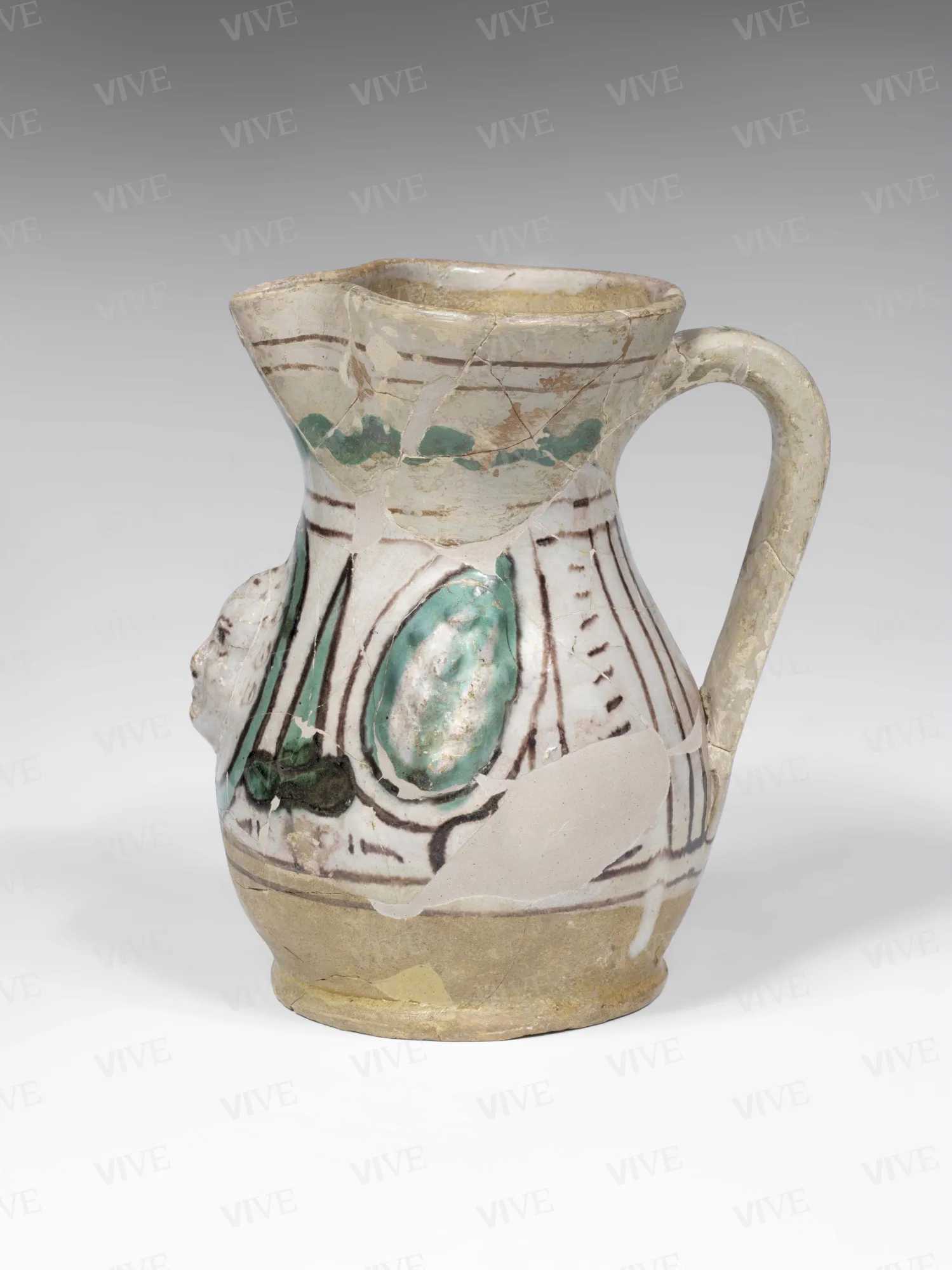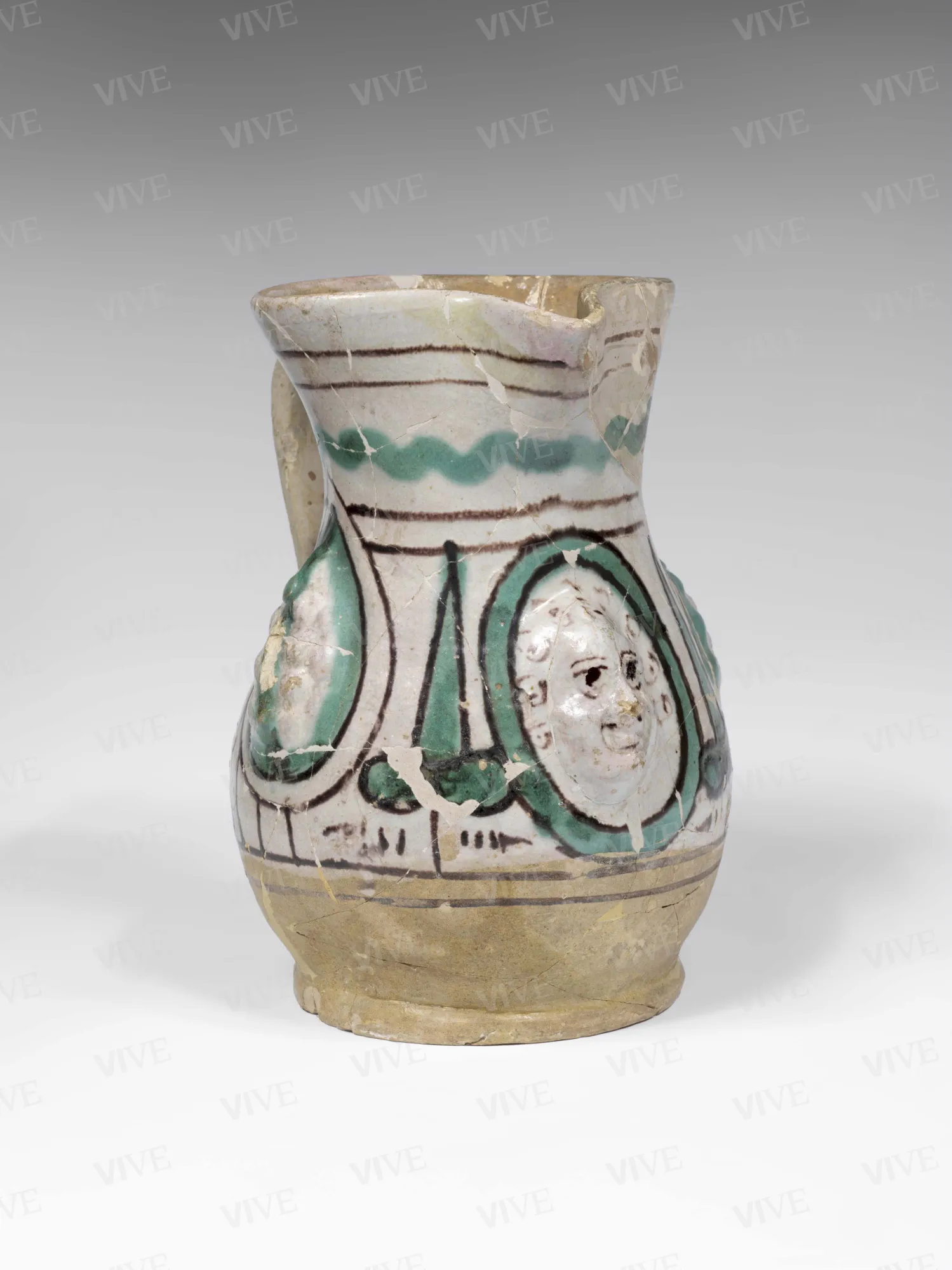Pitcher with protomes and pine cones
Orvieto milieu Low Middle Ages
Proto-majolica pitcher with trefoil rim, flared neck, ovoid body, flat base, and reconstructed banded handle. Geometric and phytomorphic decorations traced in green and brown together with applied modeled decorations depicting a human protome flanked by two pine cones can be seen on the outer surface above a thin stanniferous coating.
Proto-majolica pitcher with trefoil rim, flared neck, ovoid body, flat base, and reconstructed banded handle. Geometric and phytomorphic decorations traced in green and brown together with applied modeled decorations depicting a human protome flanked by two pine cones can be seen on the outer surface above a thin stanniferous coating.
Details of work
Catalog entry
Proto-majolica pitcher with trefoil rim, flared neck, ovoid body, flat base, and reconstructed banded handle. The find has a yellowish glaze on the interior and in the lower portion of the outer surface (except for the bottom), which is covered with a layer of adherent opaque whitish glaze on which pictorial decorations have been traced. On the neck, a wavy green band motif is visible below two brown lines intended to define the rim; on the body of the vessel, within a band bounded by double parallel lines in manganese brown, there are three applied decorations inscribed within oval medallions and alternating with a trefoil motif with a central pointed leaf profiled in brown and filled in with green. The applied decorations include a human protome with barely visible brown brush strokes flanked by two pine cones filled in with green.
The find belongs to the so-called Proto-majolica phase. This term, taken from the designations traditionally used to define the periods of ancient Attic pottery, adopted by Gaetano Ballardini when he systematically classified Italian majolica, is used to chronologically define a type of glazed ceramic tableware produced from the mid-thirteenth century in central and northern Italy and whose basic characteristic is the presence of a stanniferous vitrified glaze over the container’s main surface, which is also embellished with pictorial decorations in copper green and manganese brown, while secondary surfaces are simply covered with a plumbiferous glaze. Proto-majolica forms are divided into open and closed types and are characterized by numerous variants and subvariants often produced in specific areas, such as the pelican mug typical of the Umbria-Latium area. Since the class occupies a rather broad chronological range, it is still problematic to date in order to establish a satisfactory overview of its evolution, but in central Italy the area occupied by this new class—which in terms of technique and final product was aimed at replacing previous tableware such as green glazed ceramics, underglazed painted ceramics, and Latium ceramics—would seem to be the city of Pisa. Generally speaking, it is possible to observe an “early phase” (1200–1250), relating exclusively to the production of Attic Majolica basins for architectural decorations; a “developed phase,” which can be dated to 1250–1350 when Attic Majolica, produced as tableware ceramics, is found in significant numbers in most archaeological sites; there is then a third, “late phase,” which goes from 1350 to the first half of the fifteenth century, during which, both morphologically and decoratively, we can see a series of internal elaborations that in some cases evolve into subsequent Renaissance forms. This large class contains distinct productions on an almost regional basis. Umbrian production—which this particular artifact belongs to—is usually associated with northern Latium production, which in fact would seem to be strongly influenced by the former. The human protomes and applied pine cones, which are clearly visible on the item, are common in ceramic artifacts produced in Orvieto and the upper Latium area, as is the pictorial trefoil decoration characterized by numerous internal variations.
Beatrice Brancazi
State of conservation
The vessel is in a fairly good state, although it has been restored in several sections on two separate occasions. The first, probably datable to 1994, is more imitative and was limited to the handle, part of the neck, and the rim; the second and more obvious restoration (in white) was undertaken on different areas of the vessel and probably dates from 1998.
Restorations and analyses
The artifact has been restored twice. The first restoration took place in 1994; the second in 1998.
Provenance
The artifact belongs to the collection of Giulio Del Pelo Pardi. In 1950, Del Pelo Pardi donated it, accompanied by a typewritten catalog prepared by Pericle Perali, to the Museo di Palazzo Venezia, where its traces were soon lost. In the 1990s, during a survey undertaken to retrieve and review the materials in the museum's depository, a collection was recovered and assumed to be the Del Pelo Pardi collection.
Exhibition history
Orvieto, Museo della Tradizione Ceramica, Palazzo Simoncelli, Oltre il frammento, 18 December 1999–23 January 2000;
Faenza, Museo Internazionale delle Ceramiche, Oltre il frammento, 20 May–30 September 2000;
Rome, Museo Nazionale di Palazzo Venezia, Oltre il frammento, 25 October 2001–31 January 2002.
References
Berti Graziella, Tongiorgi Ezio, Ceramiche importate dalla Spagna nell’area pisana dal XII al XV secolo, Pisa 1977;
Francovich Riccarco, La ceramica a Siena e nella Toscana Meridionale (secoli XIV–XV). Materiali per una tipologia, Firenze 1982;
Nepoti Sergio, La maiolica arcaica nella valle padana, in La ceramica medievale nel mediterraneo occidentale, Atti del congresso internazionale organizzato dal Dipartimento di Archeologia e Storia delle Arti all’Università degli Studi di Siena e dal Museo delle Ceramiche di Faenza (Siena- Faenza, 8-13 ottobre 1984), Firenze 1986, pp. 409-418;
Satolli Alberto, La ceramica orvietana nel medioevo, Orvieto 1983, p. 104, n. 161; p. 105, n. 164;
Sconci Maria Selene (a cura di), Oltre il frammento: forme e decori della maiolica medievale orvietana. Il recupero della collezione Del Pelo Pardi, Roma 2000, p. 106, n. 66, p. 107, n. 67;
Casocavallo Beatrice, Le ceramiche rivestite bassomedievali, Quaranta Paola, Casocavallo Beatrice (a cura di), La tavola imbandita. Ceramiche ceretane tra medioevo e rinascimento, catalogo della mostra (Tarquinia, Palazzo Comunale, Sala del Monte di Pietà, 10-30 novembre 2013), Acquapendente 2013, pp. 14-35;
Brancazi Beatrice, Cencelle V. Figure dal sottosuolo. I motivi decorativi della Maiolica Arcaica da Cencelle, Roma 2021.














